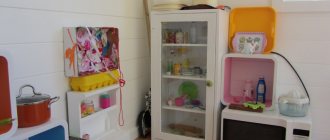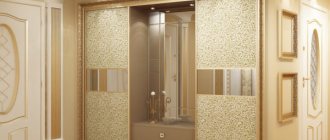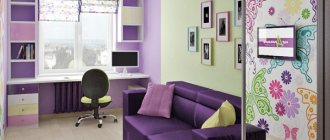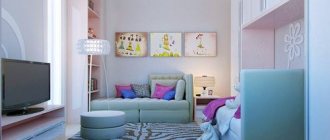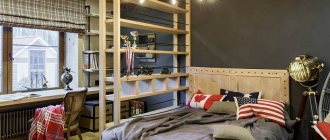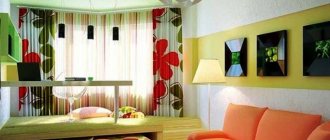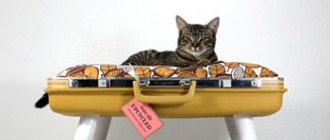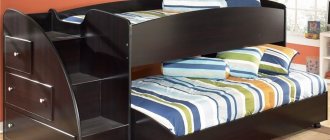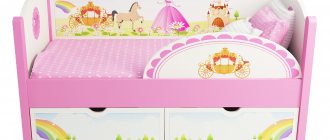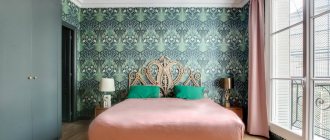You can make furniture for your child’s room yourself. Purchased models cannot always satisfy parents' needs in terms of price and quality. Therefore, many fathers who have carpentry and carpentry skills are happy to arrange a nursery based on their own ideas about the convenience and functionality of cribs, cabinets, tables and chairs. In their opinion, children's furniture must certainly be original and appeal to kids.
You can make furniture for your child’s room yourself.
Main requirements for furniture
Furnishings in a children's room must meet a number of necessary conditions. When arranging a room, you need to remember that safety is most important. Children's furniture is made mainly with streamlined shapes so that the baby does not accidentally get hurt or hurt himself. For the same purpose, for a young child, the best option would be a soft coating on most surfaces.
Furniture must also meet aesthetic requirements. It is advisable to choose everything – from the color scheme to the shape – that is pleasing to the eye. Light tones are used in natural combinations. Bright accents are welcome only in drawings and ornaments.
In my opinion, children's furniture must certainly be original and appeal to kids.
Do-it-yourself children's furniture meets the needs of parents, it is durable and costs much less than ready-made ones.
Furnishings in a children's room must meet a number of necessary conditions.
Basic colors of laminated chipboard for play walls and shelving
| Milanese nut | light beech | beech | white |
| green | blue | yellow | red |
It is possible to choose a different color of the product from the catalog in the sales department; the price of the product may change after approval of the technical specifications and its coordination with the furniture factory technologist.
Materials used for the manufacture of children's furniture
The base of the products should be made from natural materials. To do this, choose wood or its derivatives, fabric (dense and with short soft pile, depending on the purpose), and hypoallergenic filler.
Children's furniture is made mainly with streamlined shapes so that the baby does not accidentally get hurt or hurt himself.
To make children's furniture with your own hands, you need fastenings:
- corners;
- self-tapping screws;
- closers (if a transformation mechanism is planned).
Furniture must also meet aesthetic requirements.
Some materials can be found at home - for example, upholstery fabric. The rest is purchased in specialized stores or ordered online. Compared to the finished product, the costs will be 2-3 times less.
Bright accents are welcome only in drawings and ornaments.
The originality of this design depends on the child’s passion.
To ensure that children's furniture is durable, non-toxic adhesives and varnish (for covering surfaces) are used in its manufacture.
Do-it-yourself children's furniture meets the needs of parents, it is durable and costs much less than ready-made ones.
Tools you may need:
- screwdriver;
- screwdriver;
- construction stapler;
- wood hacksaw.
The base of the products should be made from natural materials.
Furniture for a baby must be safe, so everything - from material to fastenings - is selected in accordance with this requirement.
To make surfaces even and smooth, use sandpaper.
Some materials can be found at home - for example, upholstery fabric.
Safety of finishing materials for children's rooms
Plaster, carpet, adhesives, paints, varnishes and many other materials used for finishing work can become hazardous to a child’s health. This is due to the fact that many of them contain phenols, benzenes, and toluenes, which negatively affect the nervous system and reproductive organs. Therefore, it is important to choose a company that can make furniture from the safest materials.
Health safety will be ensured by materials such as clay plaster (it will help maintain the required humidity in the room), natural bamboo carpet (it can also regulate humidity and temperature), and natural paints.
Natural stones are often used in modern design projects for children's rooms. Please ensure that the mineral has evidence of radiation quality.
Electromagnetic radiation also negatively affects the child’s well-being. Its source, as a rule, is electrical wiring and transformers. But “warm floors” have the most negative effect - often electromagnetic radiation exceeds the norm by 10 times.
Making a pouf
To make frameless furniture, you will need fabric and filling. For the cover, use a thick fabric such as raincoat fabric. It is better to choose a color that is not too bright and practical. As a filler, you need to use a “fractional” base - foam balls. The ease of use of the ottoman depends on the quality of the contents.
Compared to the finished product, the costs will be 2-3 times less.
First, according to the pattern, you need to sew a cover - round, elongated, square. Place the filling inside the base through the unsewn hole. For ventilation, make several small holes at the top, through which small contents will not pass. To make the ottoman even softer, sew a cape from velvety fabric.
To ensure that children's furniture is durable, non-toxic adhesives and varnish (for covering surfaces) are used in its manufacture.
Primary colors of laminated chipboard products (except for play furniture and Economy series)
It is possible to choose a different color of the product from the catalog in the sales department; the price of the product may change after approval of the technical specifications and its coordination with the furniture factory technologist.
| Russian laminate: yellow 730 | Russian laminate: green steppe 763 | Russian laminate: sky blue 720 | Russian laminate: red 740 |
| Uniform: beech bavaria 11265 | Russian laminate: Alder 491/492 |
Making a bed
A sleeping place for a child can be easily equipped from scrap materials. Use chipboard or MDF boards, as well as solid wood. For supports, bars of the same length are processed. It is better to make the bottom from lamellas rather than plywood. This is a more labor-intensive process, but this way the crib will be better ventilated.
To make surfaces even and smooth, use sandpaper.
Children's furniture can be varnished or painted. To do this, choose special non-toxic compounds.
The rest is purchased in specialized stores or ordered online
Manufacturing of children's play furniture
Items intended to entertain a child can be made using simplified sketches. For this, inexpensive materials are used - chipboard, plywood, thick cardboard. The originality of this design depends on the child’s passion. Popular play furniture:
- kitchens;
- hospitals;
- cars;
- ships;
- rockets;
- aircraft.
Light tones are used in natural combinations.
Some models can be combined to save room space. For example, make a crib in the shape of a racing car.
The base of the products should be made from natural materials.
It is important to make the environment in the baby’s room attractive and cheerful, since the child is here all the time.
Furniture for a baby must be safe, so everything - from material to fastenings - is selected in accordance with this requirement. It is better to cut off all protruding corners and make them streamlined.
In their opinion, children's furniture must certainly be original and appeal to kids.
Children's furniture will acquire an aesthetic appearance if you make some adjustments to its decoration.
Popular materials
The most common materials for making children's furniture today are MDF boards and chipboards. MDF boards are a good substitute for natural wood. Made from wood fiber base. It is completely safe for children's health. Due to its properties, it is successfully used in the manufacture of safe furniture for children, both for toddlers and teenagers. Chipboard boards are less safe for children's health, since formaldehyde resins are used in the production of panels. However, today the level of resins is carefully controlled. Chipboards whose resin level exceeds the E1 value established by regulatory authorities are not allowed for furniture production. In this case, chipboards are used mainly only as the back walls of cabinets or the bottom of drawers, which does not pose any danger to the health of the child. When choosing furniture made from safe materials for a children's room, you should give preference to combined options. When choosing children's safe furniture, you should definitely ask the seller about the availability of certificates confirming the products' compliance with all necessary safety standards. In addition, you must inspect the product yourself for chips and damage.
All attention to detail!
Also no less important materials are the edges of objects. Today, melamine edges are used for edging children's furniture, which have the properties of quickly deteriorating. This will not only lead to a rapid loss of the external appearance of children's furniture, but edge dust particles may enter the child's respiratory tract. More reliable and safe materials for furniture edges are PVC, polypropylene, thermoplastic or polymethyl methacrylate. The edges made from these materials not only prevent formaldehyde from escaping, but also round the corners of the furniture, making them safer for active children.
Basics of decorating children's furniture
It is important to make the environment in the baby’s room attractive and cheerful, since the child is here all the time. Children's furniture will acquire an aesthetic appearance if you make some adjustments to its decoration. The decor can be in the form of carved parts of the crib and other objects, drawn images or self-adhesive appliqués. For a girl’s room, choose calm plant motifs, while boys prefer dynamic scenes from games or cartoons.
To decorate furniture, use hypoallergenic compounds.
. To make the drawing even, prepare a stencil - it can be cut from a thick file folder.
To decorate furniture, use hypoallergenic compounds. To make the drawing even, prepare a stencil - it can be cut from a thick file folder.
To make the drawing even, prepare a stencil - it can be cut from a thick file folder.
For a girl’s room, choose calm plant motifs, while boys prefer dynamic scenes from games or cartoons.
